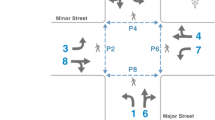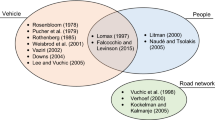Abstract
The purpose of this research is to provide a faster and more efficient method to determine traffic density behavior for long-term congestion management using minimal statistical information. Applications include road work, road improvements, and route choice. To this end, this paper adapts and generalizes two analytical models (for non-peak and peak hours) for the probability mass function of traffic density for a major highway. It then validates the model against real data. The studied corridor has a total of 36 sensors, 18 in each direction, and the traffic experiences randomly occurring service deterioration due to accidents and inclement weather such as snow and thunderstorms. We base the models on queuing theory, and we compare the fundamental diagram with the data. This paper supports the validity of the models for each traffic condition under certain assumptions on the distributional properties of the associated random parameters. It discusses why these assumptions are needed and how they are determined. Furthermore, once the models are validated, different scenarios are presented to demonstrate traffic congestion behavior under various deterioration levels, as well as the estimation of traffic breakdown. These models, which account for non-recurrent congestion, can improve decision making without the need for extensive datasets or time-consuming simulations.
















Similar content being viewed by others
References
Alfa A, Neuts M (1995) Modelling vehicular traffic using the discrete time Markovian arrival process. Transp Sci 29:109–117
Anbaroglu B, Heydecker B, Cheng T (2014) Spatio-temporal clustering for non-recurrent traffic congestion detection on urban road networks. Transp Res Part C: Emerg Technol 48:47–65
Arnesen P, Hjelkrem OA (2018) An estimator for traffic breakdown probability based on classification of transitional breakdown events. Transp Sci 52(3):593–602. https://doi.org/10.1287/trsc.2017.0776
Baykal-Gürsoy M, Xiao W (2004) Stochastic decomposition in M/M/\(\infty \) queues with Markov-modulated service rates. Queueing Syst 48:75–88
Baykal-Gürsoy M, Duan Z, Xu H (2009a) Stochastic models of traffic flow interrupted by incidents. IFAC Proc Vol 42(15):442–449
Baykal-Gürsoy M, Xiao W, Ozbay K (2009b) Modeling traffic flow interrupted by incidents. Eur J Oper Res 195(1):127–138
Baykal-Gürsoy M, Figueroa Candia M, Duan Z (2019) Completion times on jobs on two-state service processes and their asymptotic behavior. under review
Celikoglu HB (2014) Dynamic classification of traffic flow patterns simulated by a switching multimode discrete cell transmission model. IEEE Trans Intell Transp Syst 15(6):2539–2550
Celikoglu HB, Silgu MA (2016) Extension of traffic flow pattern dynamic classification by a macroscopic model using multivariate clustering. Transp Sci 50(3):966–981
Cheah J, Smith J (1994) Generalized M/G/C/C state dependent queuing models and pedestrian traffic flows. Queueing Syst 15:365–385
Chen Z, Liu XC, Zhang G (2016) Non-recurrent congestion analysis using data-driven spatiotemporal approach for information construction. Transp Res Part C Emerg Technol 71:19–31
Chiou S-W (2016) A robust urban traffic network design with signal settings. Inf Sci 334:144–160
Daganzo CF (1994) The cell transmission model: a dynamic representation of highway traffic consistent with the hydrodynamic theory. Transp Res Part B Methodol 28(4):269–287
Daganzo CF (2006) In traffic flow, cellular automata= kinematic waves. Transp Res Part B Methodol 40(5):396–403
Dailey DJ (1999) A statistical algorithm for estimating speed from single loop volume and occupancy measurements. Transp Res Part B Methodol 33(5):313–322
Darroch GNJN, Morris R (1964) Queues for vehicle-actuated traffic light. Oper Res 12:882–895
Dong J, Mahmassani HS (2012) Stochastic modeling of traffic flow breakdown phenomenon: application to predicting travel time reliability. IEEE Trans Intell Transp Syst 13(4):1803–1809
Dunne MC (1967) Traffic delays at a signalized intersection with binomial arrivals. Transp Sci 1:24–31
Gazis DC (2006) Traffic theory, vol 50. Springer, Berlin
Han Y, Ahn S (2018) Stochastic modeling of breakdown at freeway merge bottleneck and traffic control method using connected automated vehicle. Transp Res Part B Methodol 107:146–166
Heidemann D (July 1996) A queueing theory approach to speed-flow-density relationships. In Proceedings of the 13th International Symposium on Transportation and Traffic Theory, France
Heidemann D (2001) A queueing theory model of nonstationary traffic flow. Transp Sci 35:405–412
Jain R, Smith J (1997) Modeling vehicular traffic flow using M/G/C/C state dependent queueing models. Transp Sci 31:324–336
Keilson J, Servi L (1993) The matrix M/M/\(\infty \) system: retrial models and Markov modulated sources. Adv Appl Prob 25:453–471
Kerner BS, Klenov SL, Wolf DE (2002) Cellular automata approach to three-phase traffic theory. J Phys A Math Gen 35(47):9971
Kurzhanskiy AA (2009) Set-valued estimation of freeway traffic density. IFAC Proc Vol 42(15):271–277
Kwon J, Mauch M, Varaiya P (2006) Components of congestion: Delay from incidents, special events, lane closures, weather, potential ramp metering gain, and excess demand. Transportation Research Record: Journal of the Transportation Research Board, 1959(1959):84–91. ISSN 0361-1981. https://doi.org/10.3141/1959-10. http://trrjournalonline.trb.org/doi/10.3141/1959-10
Laharotte PA, Billot R, El Faouzi NE (2017) Detection of non-recurrent road traffic events based on clustering indicators. In: ESANN
Lehoczky J (1972) Traffic intersection control and zero-switch queues. J Appl Prob 9:382–395
Lighthill M, Whitham G (1955) On kinematic waves: II. A theory of traffic on long crowded roads. In: Proc. Roy. Soc. London Ser. A 229, pp 317–345
Maerivoet S, De Moor B (2005) Cellular automata models of road traffic. Phys Rep 419(1):1–64
Massey FJ Jr (1951) The Kolmogorov–Smirnov test for goodness of fit. J Am Stat Assoc 46(253):68–78
May A, Keller H (1967) Non-integer car-following models. Highw Res Rec 199:19–32
Muñoz L, Sun X, Horowitz R, Alvarez L (2003) Traffic density estimation with the cell transmission model. In: Proceedings of the 2003 American Control Conference, 2003., volume 5, pp 3750–3755
Nagel K, Schreckenberg M (1992) A cellular automaton model for freeway traffic. Journal de Physique I 2(12):2221–2229
Nelder JA, Mead R (1965) A simplex method for function minimization. Comput J 7(4):308–313
Newell G (1965) Approximation methods for queues with application to the fixed-cycle traffic light. SIAM Rev 7(2):223–240
Newell G (1971) Applications of queueing theory. Chapman and Hall, London
Newell GF (1993) A simplified theory of kinematic waves in highway traffic, part I: general theory. Transp Res Part B Methodol 27(4):281–287
NOAA. National climatic data center. Accesed 2015–2016
Olver FW (2010) NIST handbook of mathematical functions hardback and CD-ROM. Cambridge University Press, Cambridge
Panichpapiboon S, Leakkaw P (2017) Traffic density estimation: a mobile sensing approach. IEEE Commun Mag 55(12):126–131
Polson N, Sokolov V (2017) Deep learning for short-term traffic flow prediction. Transp Res Part C Emerg Technol 79:1–17
Richards P (1956) Shock waves on the highway. Oper Res 4:42–51
Ross S (1996) Stochastic processes, vol 2. Wiley, New York
Schrank D, Eisele B, Lomax T, Bak J (2015) Urban mobility scorecard. College Station: Texas A&M Transportation Institute and INRIX (August)
Skabardonis A, Petty K, Varaiya P, Bertini R (1998) Evaluation of the Freeway Service Patrol (FSP) in Los Angeles, ucb-its-prr-98-31. Technical report, California PATH Research Report, Institute of Transportation Studies, University of California, Berkeley
Skabardonis A, Petty K, Varaiya P (2003) Measuring recurrent and non-recurrent traffic congestion. In: Proc. of the 82th Annual Meeting of the Transportation Research Board. volume CD-ROM, Washington D.C
Tanner J (1953) A problem of interface between two queues. Biometrica 40:58–69
Thakur G. S, Huiz P, Helmy A (2012) Modeling and characterization of urban vehicular mobility using web cameras. In: Proceedings of the 2012 IEEE Conference on Computer Communications Workshop, pp 262–267
Treiber M, Hennecke A, Helbing D (2000) Congested traffic states in empirical observations and microscopic simulations. Phys Rev E 62(2):1805
Tricomi FG, Erdélyi A (1951) The asymptotic expansion of a ratio of gamma functions. Pac J Math 1(1):133–142
Vandaele N, VanWoensel T, Verbruggen N (2000) A queueing based traffic flow model. Transp Res D Transp Environ 5:121–135
Wang S, Ahmed N (2017) Dynamic model of urban traffic and optimum management of its flow and congestion. Dyn Syst Appl 26(3–4):575–587
Zhang S, Wu G, Costeira JP, Moura JM (2017) Understanding traffic density from large-scale web camera data. arXiv preprint arXiv:1703.05868
Zheng J, Liu HX (2017) Estimating traffic volumes for signalized intersections using connected vehicle data. Transp Res Part C Emerg Technol 79:347–362
Acknowledgements
The authors are grateful to Peter J. Jin for providing the data and to Marcelo Figueroa-Candia for helping with data preprocessing. The first author would like to thank CNPq (Brazilian National Council for Scientific and Technological Development) for funding this research.
Author information
Authors and Affiliations
Corresponding author
Additional information
Publisher's Note
Springer Nature remains neutral with regard to jurisdictional claims in published maps and institutional affiliations.
Appendices
Appendix 1: Proof of Proposition 1
We will derive the probability mass function of the random number of cars on a segment from Eqs. 1, 4, 5, 9, 10, and 11.
Substituting \(\left( 1-p\left( 1-\frac{\varGamma (b)}{\varGamma (a)}\right) \right) = m\), we have
Therefore
Now we will show that \(p\left( 1-\frac{\varGamma (b)}{\varGamma (a)}\right) \) is approximately equal to \(\frac{r}{r+f}\) for small a and b.
Claim: \(p\left( 1-\frac{\varGamma (b)}{\varGamma (a)}\right) \approx \frac{r}{r+f}\) for small a and b.
For \(x>0,\)
The above relation for \(x=a=\frac{f}{\mu }\) and \(x=b=\frac{f}{\mu } + \frac{r}{\mu '},\) implies
Using the approximation (8) for \(z=1\), since \(a \ll 1,\)\(b\ll 1\), and \(b-a \ll 1\), one can deduce that \( \frac{\varGamma (b+1)}{\varGamma (a+1)}\) is approximately equal to 1. Thus
Because \(p= \frac{r + f\frac{\mu '}{\mu }}{r+f}\), the result follows
As a result, the probability mass function of density tends to the mixture \(P\{X=k\}=\frac{r}{r+f} X_g+\frac{f}{r+f}X_b,\) where \(X_g\) follow a Poisson with parameter \((\lambda /\mu )\) and \(X_b\) follow a Poisson with parameter \((\lambda '/\mu ')\).
The error of the approximation can be derived similarly to the previous proof
One can see that when f and r are smaller in comparison to \(\mu \) and \(\mu '\), respectively, this approximation of the weight of the mixture holds. Figure 17 shows the error for different ratios between f and \(\mu \) and r and \(\mu '\). We can see that when they are around \(1\%\) of the \(\mu \) and \(\mu '\), the error is on the order of \(10^{-3}\), and it decreases to lower than \(10^{-5}\) when the ratios drop to \(0.01\%\).
Appendix 2: Tables containing AIC for each sensor
Rights and permissions
About this article
Cite this article
Lopes Gerum, P.C., Benton, A.R. & Baykal-Gürsoy, M. Traffic density on corridors subject to incidents: models for long-term congestion management. EURO J Transp Logist 8, 795–831 (2019). https://doi.org/10.1007/s13676-019-00149-2
Received:
Accepted:
Published:
Issue Date:
DOI: https://doi.org/10.1007/s13676-019-00149-2





